CTV NEWSCHANNEL: RICHARD ON SOME OF ANNE HECHE’S BEST ROLES.
 CTV NewsChannel anchor Marcia MacMillan and I look at the roles that made Anne Heche a star.
CTV NewsChannel anchor Marcia MacMillan and I look at the roles that made Anne Heche a star.
Watch the whole thing HERE!
 CTV NewsChannel anchor Marcia MacMillan and I look at the roles that made Anne Heche a star.
CTV NewsChannel anchor Marcia MacMillan and I look at the roles that made Anne Heche a star.
Watch the whole thing HERE!
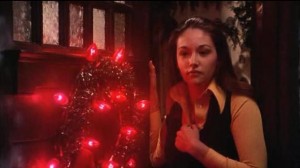 “If this movie doesn’t make your skin crawl . . . it’s on too tight!” — advertising tagline for Black Christmas
“If this movie doesn’t make your skin crawl . . . it’s on too tight!” — advertising tagline for Black Christmas
Canada is a nation of firsts. Torontonian Don Munroe built the first table hockey game here in the early 1930s. Other parts of the country can lay claim to the Jolly Jumper, the celebration of Labour Day, artificial hearts, the Robertson square-head screwdriver, and it was a Canadian who mixed the world’s first Bloody Caesar. The country has broken ground in many fields, including film. Florence Lawrence, the first performer to be identified by name on screen, was born in Hamilton, Ontario, while the first aboriginal actor to portray a Native American on television, Jay Silverheels, hailed from the Six Nations Indian Reserve in Brantford, Ontario.
In a more macabre vein, without a groundbreaking 1974 Canadian horror film there might never have been a Jason Voorhees, Freddy Krueger or Michael Myers. Between them the gruesome threesome have sliced and diced their way through at least two dozen movies, but the mayhem they imposed on promiscuous college girls and studly teens owes much to one film made in Toronto, a movie Film Threat magazine calls “the first modern slasher movie.”
Director Bob Clark didn’t invent the slasher film with Black Christmas — arguably Psycho, Peeping Tom or Bay of Blood (Reazione a catena) were the granddaddies of gore — but he did establish the format. Mix and match the fear of an unwelcome visitor to a sorority house brimming with randy college girls, a holiday-turned-violent theme, the anonymous phone call used to terrorize girls, a motiveless killer, a mysterious male stalking young women, and a female lead who must conquer her own fear in order to stay alive and you have the plot of dozens of films that were to follow.
Shot in Toronto between February and May 1974 on a budget of roughly $600,000, Black Christmas is about an unseen psychotic killer named Billy who makes disturbing, obscenity laced phone calls to a group of sorority girls. Soon he escalates from one-sided phone sex to dispatching the girls one by one in brutal fashion.
“It was originally called Stop Me,” says Clark, who was killed in an April 2007 car accident, “I don’t think I’m taking unfair credit, but Black Christmas was my title, my idea. I love the contrast of the idea of Christmas, the jolliest of all seasons with this dark kind of imagery. Both a horror film and Christmas have tremendous trappings that make a nice juxtaposition.”
Apparently others agreed with him. In the next two decades a tsunami of holiday themed horrors — Christmas and otherwise — drifted into theaters; My Bloody Valentine, New Year’s Evil, April Fools Day and a Santa’s sack of movies featuring death by Christmas tree light.
What sets Black Christmas apart from the rest of the Christmas horror pack are the memorable characters. The standout is a pre-Lois Lane Margot Kidder as the sharp-featured brunette Barb, whose alcoholic tendencies foreshadowed the actress’s troubled real life. “One of my favorite memories is Margot coming to the set for her famous turtles-screwing-for-three-days scene,” says Clark. “She was supposed to be imbibing, and she was, to get in character. She was definitely there.”
As Barb she thumbs her nose at any form of authority — be it the thick as a brick Sgt. Nash or the threatening caller — and steals every scene she’s in with her reckless energy. When she slurs, “This is a sorority house, not a convent,” it is lewd, raunchy and sexy-funny.
Argentine-born Olivia Hussey as Jess is not the typical sorority slasher movie heroine. Hussey brings a quiet strength to Jess that hints at a fountain of inner resolve. It has often been said that slasher films are the most Republican of genres because of the punishment meted out on people who go against conservative middle-American values. In other words smoking pot and jumping from bed to bed is bound to earn you a one way ticket to hell courtesy of some masked madman, while the virgin of the group usually makes it through bloodied but unbowed. In Black Christmas Jess rebels against her boyfriend, and is planning to have an abortion. Clearly she is no virgin, and yet she is the sole survivor of Billy’s rampage.
The boyfriends of Claire and Jess — Chris Hayden (Art Hindle) and Peter Smythe (Keir Dullea) — are studies in opposites. The Halifax-born Hindle plays Chris as earnest and loving (although he does wear a raccoon coat), a stand-up guy who loves his girlfriend even if their relationship is chaste.
Keir Dullea as Peter is a different story. Peter is an eccentric musician who realizes too late that he has traded one passion for another. His love of music overshadowed his feelings for Jess and now she is backing away from him. He is prone to fits of anger, and this hot-headed behavior is the perfect red herring (or McGuffin as Hitchcock used to call them) to make us think he is the killer. It is interesting to imagine how the character might have differed if Clark’s first choice for Peter, Malcolm McDowell, had accepted the part.
During shooting Dullea was only available for a week as he had other commitments in Europe. In his short time on the film, he never met Margot Kidder and worked with John Saxon only briefly. “My total experience with working with anybody was Olivia Hussey,” he says. Clark shot all of Dullea’s scenes first and in editing made it appear as though he was there for the whole time.
Like Black Christmas’s other imported movie star, Olivia Hussey, Keir Dullea’s early career showed great promise, but didn’t mature into full-blown movie stardom. Two films hinted at his star potential — 1963’s Lisa and David and Bunny Lake is Missing in 1965 — but it wasn’t until he played astronaut Dave Bowman in Kubrick’s 2001: A Space Odyssey in 1968 that his full promise was reached. He failed to really capitalize on the notoriety that movie earned him, leading Noel Coward to famously quip, “Keir Dullea, gone tomorrow.”
Uncredited but very effective are the actors who voiced the obscene phone calls. The disembodied voices of unseen evil were supplied by a number of people including Bob Clark, actor Nick Mancuso and several female actors. “[The phone calls are] a compilation of about five actor’s voices,” says Clark. “I remember what Nick brought it to was an intensity that certainly I had never seen before,” said sound designer and composer Carl Zitrer who engineered the calls, mixing in reverb and an array of spooky sounds.
Was Black Christmas the inspiration for John Carpenter’s seminal slasher flick Halloween? It’s a question that has sparked a fair amount of debate, so let’s break it down. There are similarities that cannot be denied between the two films.
Most obviously both films open with a point of view shot of the killer creeping around the outside of a house at night. Clark uses this shot, and many POV angles to great effect in Black Christmas, but he wasn’t the first to use the subjective camera to create fear. Clark simply took an old idea and put a new spin on it. He would later say that he hoped to break new ground by “employing some, if not new, certainly reworked and rethought cinematic ideas.” Mario Bava used distorted POV in Blood and Black Lace, and Hitchcock used it in the shower scene in Psycho, just to name a couple famous examples. Clark’s innovation in Black Christmas was to make the point of view shot his centerpiece, using it create a mood of terror rather than a secondary complement to the horror already on screen.
Clark’s film is unique in that we never see the killer, he moves in the shadows, a subliminal figure of terror unlike the very visible Michael Myers in Halloween. What they share, however, is motive – neither of them has one. They are striking out at these victims for no reason. Carpenter says he modelled Michael Myers’ relentless passion for killing on a film by Michael Crichton. “I must tell you that I cribbed from Westworld – Yul Brynner as a robot gunfighter who malfunctions and keeps coming after them. I just took it a step further, but I gave you no explanation.” Pre-Black Christmas movie homicidal maniacs always had a motive, but we never know why Billy targeted the Pi Kappa Sig house or its inhabitants.
There is one major difference between the two – Billy is literally a raving lunatic, screaming and grunting his way through the film, whereas Michael Myers (and later, Jason Voorhees) is unnaturally silent.
It may have just been weird synchronicity that two films about homicidal maniacs open with unusual POV shots, and share an ideological bent, but there is no question that Black Christmas and Halloween are similar.
“I absolve John Carpenter every time,” says Clark. “The facts are that I was going to direct a film John wrote a couple of years after Black Christmas. He was a big fan of Black Christmas… and he asked me if I was ever going to do a sequel.
“I said, ‘I would make it the following fall and somehow in the interim the killer had been caught and had been institutionalized. I would have him escape one night, and now he is free in the community… and he starts staking them again at the Black Christmas sorority house, and I was going to call it Halloween.’
“I think he was influenced by it, as were a few others. When you think about what John Carpenter did, [however], wrote a script — really quite different from that idea —directed it, edited it and did the music. It was a terrific piece of work. Maybe the title Halloween he should have given me a little of, but I didn’t own that either.”
Despite the rave reviews, and the prediction of Olivia Hussey’s personal psychic that the film would make a bundle, Black Christmas didn’t fare well at the box-office in the USA. To boost admissions, in some markets the movie’s name was changed to A Stranger in the House to avoid confusion with the flurry of blaxploitation films that were appearing at the time. It was also released as Silent Night, Evil Night.
Viewed through today’s eyes the movie holds up. It is very stylish, although slower in sections, and with a lower body count than modern horror fans are used to, but it is still capable, more than three decades after its conception, to raise goose bumps. A testament to the film’s enduring ability to scare came when NBC cancelled an airing of the film because they felt it was too intense for television audiences. It has also earned the seal of approval from Quentin Tarantino, who cites it as one of his favorite movies.
“It’s an interesting film.” says Clark, “I thought it was a good, scary, classic horror story, and those have a way of surviving.”
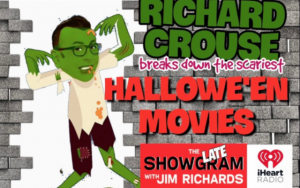 Richard joins NewsTalk 1010 host Jim Richards on the coast-to-coast-to-coast late night “Showgram” to talk about the best movies to watch on Halloween, why Canada makes great horror movies and why “Frankenstein” is still scary 88 years after its release.
Richard joins NewsTalk 1010 host Jim Richards on the coast-to-coast-to-coast late night “Showgram” to talk about the best movies to watch on Halloween, why Canada makes great horror movies and why “Frankenstein” is still scary 88 years after its release.
Listen to the whole thing HERE!
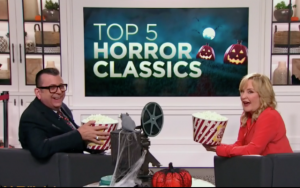 Richard sits in on Canada’s number-one rated mid-morning show, “The Marilyn Denis Show,” to discuss five of his favorite films for Halloween.
Richard sits in on Canada’s number-one rated mid-morning show, “The Marilyn Denis Show,” to discuss five of his favorite films for Halloween.
5. “A Quiet Place” from 2018, a unique and unsettling horror film.
4. “May” from 2002, directed by Lucky McKee. Really underrated horror film that deserves to be better known than it is.
3. “Psycho” from 1960, Directed by Alfred Hitchcock. I still get creeped out in the shower.
2. “Ginger Snaps” from 2000, Directed by John Fawcett. Great reinvention of the werewolf myth.
1. “The Exorcist” from 1973. Directed by William Friedkin. The single scariest night at the movies this ten year old ever experienced.
Watch the whole thing HERE!
 Richard and CP24 anchor Jamie Gutfreund have a look at the weekend’s new movies including the birthday blues of “Happy Death Day,” Jackie Chan’s return to adult drama “The Foreigner” and Liam Neeson in the self explanatory “Mark Felt: The Man Who Brought Down The White House.”
Richard and CP24 anchor Jamie Gutfreund have a look at the weekend’s new movies including the birthday blues of “Happy Death Day,” Jackie Chan’s return to adult drama “The Foreigner” and Liam Neeson in the self explanatory “Mark Felt: The Man Who Brought Down The White House.”
Watch the whole thing HERE!
 Richard sits in with CTV NewsChannel anchor Marcia MacMillan to have a look at the birthday blues of “Happy Death Day,” Jackie Chan’s return to adult drama “The Foreigner” and Liam Neeson in the self explanatory “Mark Felt: The Man Who Brought Down The White House.”
Richard sits in with CTV NewsChannel anchor Marcia MacMillan to have a look at the birthday blues of “Happy Death Day,” Jackie Chan’s return to adult drama “The Foreigner” and Liam Neeson in the self explanatory “Mark Felt: The Man Who Brought Down The White House.”
Watch the whole thing HERE!
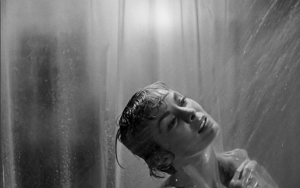 Alfred Hitchcock, knew how to scare the wits out of people. The shower scene in “Psycho,” for example, is a benchmark in cinematic fear. If he had any doubts about the effectiveness of that sequence they must have been put to bed when he received an angry letter from a father whose daughter stopped bathing after seeing the bathtub murder scene in “Les Diaboliques” and then, more distressingly, refused to shower after seeing “Psycho.” Hitch’s response to the concerned dad? “Send her to the dry cleaners.”
Alfred Hitchcock, knew how to scare the wits out of people. The shower scene in “Psycho,” for example, is a benchmark in cinematic fear. If he had any doubts about the effectiveness of that sequence they must have been put to bed when he received an angry letter from a father whose daughter stopped bathing after seeing the bathtub murder scene in “Les Diaboliques” and then, more distressingly, refused to shower after seeing “Psycho.” Hitch’s response to the concerned dad? “Send her to the dry cleaners.”
“78/52,” a new documentary from Alexandre O. Philippe spends ninety minutes exploring not only why the fifty-two second scene continues to terrify but also how it changed cinema. Drawing its title from the 78 shot set-ups it took to film the scene, the movie is an exhaustive but not exhausting look the shower sequence.
A mix of fan info and academia, it covers some familiar territory but more intriguingly looks to experts like filmmaker Guillermo del Toro and editor Walter Murch to dissect the nuts and bolts of the scene. Shot-by-shot they get inside Hitchcock and collaborator Saul Bass’s mindset, delving into the decisions, both artistic and practical, that give the sequence its power. First hand recollections come from a new and spirited interview Janet Leigh’s nude model stand-in Marli Renfro and archival conversations with Hitchcock and Leigh.
“78/52” is likely the final word on the infamous shower scene. The level of detail will enthral film geeks and Hitchcockolytes but shouldn’t dissuade more casual viewers. The enthusiasm of several of the talking heads—most notably Elijah Wood—is infectious. We can learn how and why the scene works but their passion shows why the scene is so successful from a strictly personal point of view.
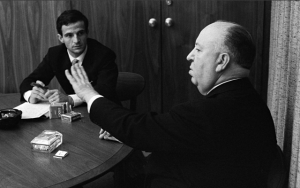 Today Alfred Hitchcock is a pop culture icon, a man revered for his mastery of the cinematic form. Films like “Vertigo,” “Rear Window,” “North By Northwest” and “Psycho” helped redefine what movies could do. More than thirty years after his 1980 death the “Daily Telegraph” said he “did more than any director to shape modern cinema.” High praise indeed but he wasn’t always so highly regarded.
Today Alfred Hitchcock is a pop culture icon, a man revered for his mastery of the cinematic form. Films like “Vertigo,” “Rear Window,” “North By Northwest” and “Psycho” helped redefine what movies could do. More than thirty years after his 1980 death the “Daily Telegraph” said he “did more than any director to shape modern cinema.” High praise indeed but he wasn’t always so highly regarded.
In 1962 Hitchcock and French director and all-round cinephile François Truffaut spent a week talking, dissecting each of the Master of Suspense’s movies. The sessions were recorded and eventually became the1966 book “Cinema According to Hitchcock,” one of the best texts ever written about film. Truffaut’s enthusiasm for his subject and the book’s success changed popular opinion and soon Hitchcock was seen in a different light, as a true cinematic artist and not simply a director of thrillers.
The new documentary “Hitchcock/Truffaut” brings the original 1962 audio interviews to life using still photos, clips from Hitch’s films and storyboards. Interspersed with the source material are new interviews with acolytes Martin Scorsese, Wes Anderson, David Fincher and Olivier Assayas.
Taken as a companion piece to the book the doc acts almost as a DVD extra, a backstage glimpse into the content that sheds light on the original document. Fans of the book will find the experience of the book enhanced by hearing the two men (through a translator) getting down to the nitty gritty of cinema nuance. Newcomers should gain a new understanding of Hitchcock as the author of his films as an auteur whose personality is imprinted on every frame of film he ever shot.
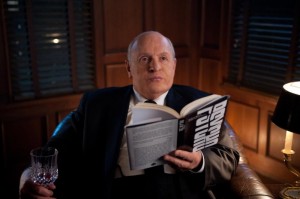 At one point in “Hitchcock,” the master of suspense (played by Anthony Hopkins), says, “Audiences want to be shocked—they want something different.” He’s referring to the content of “Psycho,” his ground breaking 1960 horror film, but while 2012 audiences may not be shocked by the content of this new biopic, they will get something different. At least if they are expecting a blow-by-blow of the shooting of the story of Norman Bates and the infamous shower scene. It’s not a retelling of the making of a movie it’s the story of the most important relationship in Hitch’s life.
At one point in “Hitchcock,” the master of suspense (played by Anthony Hopkins), says, “Audiences want to be shocked—they want something different.” He’s referring to the content of “Psycho,” his ground breaking 1960 horror film, but while 2012 audiences may not be shocked by the content of this new biopic, they will get something different. At least if they are expecting a blow-by-blow of the shooting of the story of Norman Bates and the infamous shower scene. It’s not a retelling of the making of a movie it’s the story of the most important relationship in Hitch’s life.
Following the release of “North by Northwest” Alfred Hitchcock was struggling to make a change from the big budget, elegant thrillers he was known for to something shocking. Trouble is, nothing grabbed his attention. Novels sent over for his approval are dismissed as “sleeping pills with dust jackets,” until he picks up a down-and-dirty book by Robert Bloch called “Psycho.” It’s “low budget, horror claptrap,” says his wife Alma (Helen Mirren), but he’s determined to make it, even if he has to pay for it himself.
That’s the Hollywood portion of the movie, the part Hitchcock would have called “MacGuffin,” the story element that gets the rest of the plot in gear, but isn’t terribly important to the overall story. The main thrust of the movie is Hitchcock’s quest to be relevant, to take risks, to be free—like he was before the fame—and the effect this has on his relationship with Alma.
Based on Stephen Robello’s book “Alfred Hitchcock and the Making of Psycho,” “Hitchcock” is a fast-paced and surprisingly touching marital drama peppered with lots of insider Hollywood legend.
We learn about Hitch’s troubled relationship with Vera Miles (Jessica Biel) who chose motherhood over the director’s offer to make her a star. We see his cordial relationship with Janet Leigh (Scarlett Johansson), who says, “Compared to Orson Welles, he’s a sweetheart,” and get an up-close look at familiar Hitchcock themes of voyeurism, sexual repression, betrayal, obsession and identity.
What is unexpected is the depth of the relationship between Hitch and Alma. She is seen her in a professional capacity as an assistant director, screenwriter and editor, but it is as muse, lifeblood and lone redhead in the sea of blondes that so bewitched Hitch, which is the most important part of the story.
The role of Alma is underwritten, but Mirren brings it to vibrant life, creating a character that is not supplemental to Hitchcock’s success, but the very reason for it.
It is Hopkins, however, who has the most fun here. There’s a playfulness in the performance from the fourth wall breaking narration that opens and closes to the movie to the little ballet he does as he listens to the opening night audience shriek and scream to the infamous shower scene.
Hopkins doesn’t exactly look like Hitchcock but gets the essence in a buoyant performance that betrays the fun the actor must have had creating it. He has the movie’s best lines—“I only wish (“Psycho” inspiration) Ed Gein looked more like William Holden and less like Elmer Fudd,” he says to reporters.”—but also provides many subtle shadings of the sadness Hitchcock carried with him. It is a performance that ironically could earn the Oscar that was denied to the director during his lifetime.
“Hitchcock” is a stylish film that pays homage to not only “Psycho,” but to Hitchcock’s other films, most notably the umbrella scene in Foreign Correspondent, but is also a tribute to one of the great film partnerships in Hollywood history.